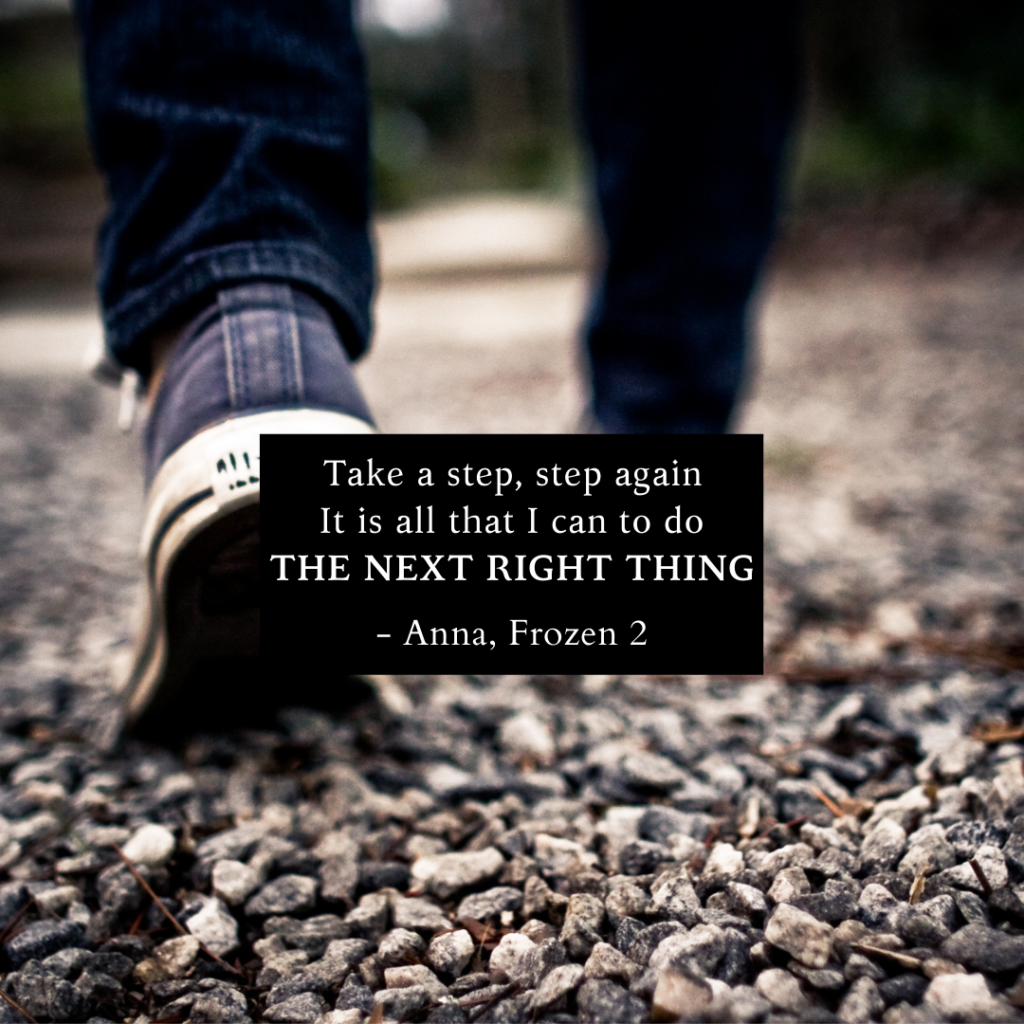“Just stop thinking about it.”
“You gotta think positively.”
“Look on the bright side!”
These types of statements often make me cringe. Can you relate? You are really struggling with something and someone tells you to change your negative thinking. Like, it’s that easy.
The Positive Self-Talk Suggestion

These statements can feel invalidating.
If you are struggling with the loss of a loved one, we don’t usually want to hear “they are in a better place.” Even if the statement is true, it is not that helpful. Just because we can logically think through a situation does not take away the emotion that goes with it.
The “just think differently” approach can also simplify what feels like a big problem.
Just replace this thought with another thought. C’mon – just do it!
My Favorite New Strategies
The good news is, positive thinking isn’t the only option.
Today’s post will review ways to change our thinking patterns and beliefs besides positive thinking. Make sure you read until the end because I’ll be talking about one of my favorite new strategies. Hint: it includes fun music and helps us shift beliefs with more joy and less effort.
Positive Self-Talk Can Work
Before we talk about new/alternate strategies, it’s important to stay that positive self-talk can be effective.
In psychology we call it “cognitive restructuring” or “challenging cognitive distortions.”
If we feel a slight tickle in our throat and assume we have Covid-19 and are going to get super sick (not speaking from experience or anything), this is a common cognitive distortion called catastrophizing. I am pretty good at this one.
If on the other hand, I felt that same tickle and thought, “my throat is dry, must be the weather change” I would probably feel pretty calm and unaffected.
How Does Cognitive Restructuring Work?
The point is: Our interpretation of situations greatly affects how we feel. Cognitive restructuring helps us to change our interpretation to feel better.
When we notice thinking patterns that are making us feel worse that we need to feel, we can challenge them. So when I notice my catastrophizing thought I might challenge my thinking by saying “Hm…. is that outcome likely?”
If I’m able to shift myself back to a more realistic or helpful thought, I will probably feel less anxious.
The Limits of Positive Self-Talk

But changing our negative thoughts has it’s limits.
Last week, I went “Live” on Facebook for the first time ever. I was pretty terrified. I was nervous to put my thoughts out there and be vulnerable. Anxious that I would mess up, look like an idiot, or say something I’d regret.
I could have challenged myself to think differently and I did do a little of this. I reminded myself that I have a message to deliver and it does not matter if it’s perfect. Someone out there might benefit from hearing what I had to say.
Willingness to Feel Uncomfortable Feelings So That We Can Live Our Values
Even after my little pep-talk, I was still anxious. The term willingness as it relates to Acceptance and Commitment therapy (an evidence-based psychological approach) means being willing to have uncomfortable feelings (e.g., anxiety, anxious thoughts) and still move in the direction of our valued behavior (for me: doing a Live video).
It was my first time doing it. Nothing was going to take that fear away completely except time and practice. My next valued steps were:
- Write a brief outline
- Message my online entrepreneur accountability group to tell them I was about to go Live (so I couldn’t back out)
- Press the “Go Live” button and begin speaking
Ultimately, I did it. And you know what? I didn’t die. It wasn’t perfect but you can check out the video about why I donated our Halloween candy here.
Changing Negative Thinking about Lifestyle Changes

What about lifestyle changes, how does all of this apply to healthier eating or exercising?
I talk a lot about the theory of motivation and the fact that shifting from external (“should”-based motivation) to internal (“want to”) motivation is key for long-term lifestyle changes. If you always tell yourself you should exercise, but that you don’t want to, over time you are unlikely to keep it up.
Similarly, if you are always saying “I shouldn’t have any sweets” or certain foods are “bad,” then often this leads to feeling restricted and eventually having a lot of the “bad” foods.
Changing from a Should to a Want to
I often talk to people about the importance of changing our beliefs and thinking patterns related to eating and exercise so that you learn to prefer your new habit changes, regardless of what the number on the scale says.
And lots of the time, people are nodding along like “yep I get it. Makes sense.”
But then look of doubt and skepticism comes up. And the question that follows: “Um, Shawn, HOW do I change my thinking?”
Change What You Can & Accept What You Can’t
Whatever mindset you are trying to shift, I encourage you to change the things you can, and accept what you can’t.
For my live video example, I changed the things I could, like reminding myself I really wanted to show up in this way and be brave. I also reached out to some friends for support and accountability.
I took a deep breath, which made me feel about 2% more relaxed and wrote my outline.
But I was still really nervous, still anxious that people would judge me or think it was silly that I showed up live to talk about Halloween candy.
A New Way of Thinking
The good news is, when positive self-talk, or replacing the old thought with a new one isn’t cutting it, you have options.
Acceptance and Commitment Therapy as mentioned above is a new-ish form of psychotherapy that is built upon the idea of psychological flexibility, acceptance, and willingness. Willingness to have negative thoughts, emotions, uncomfortably physical sensations and other things we try to avoid in service of our most valued actions.
In my Facebook Live, if I were unwilling to feel anxious and nervous, I would also be unable to deliver the message. It would have kept me from moving forward, as no amount of self-talk was going to eliminate my anxiety.
Willingness and acceptance allow us to approach our thoughts and internal “stuff” from a place of acceptance.
Like, “Yep, that anxiety and self-doubt is there.” I don’t need to change it. I can still have negative/anxious thoughts and show up with intention and courage.
3 Effective Ways to Change Negative Thinking

So what are some alternatives to positive thinking or positive self-talk? There are three great options explained below, including a quote from Anna in Frozen 2 because we ALL know Disney movies have all the wisdom.
1. Do the next small step that’s in line with your values
Take a deep breath, be brave, and do the thing anyways.
When it comes to exercise, are you struggling back and forth with “I should exercise,” “I don’t want to,” and “but I will feel better”?
If so, take a deep breath and ask yourself, “What’s consistent with my values right now?” Is it to rest on the couch? Cool, do that. Or is it to get up and go for that walk because you truly will feel better? Great, then just take the next small step towards that.
Grab your shoes. Hook your pet on the leash, and open the door. Take a few steps out.
Even if your thoughts are still screaming to stop, you do not have to get rid of them. Sometimes attempting to do so just keeps us paralyzed from doing anything at all. So take a breath, and do like Anna says in Frozen 2 and: Do the next right thing.
2. Keep a log of things that support the alternative belief or thinking pattern
In my example, my fear was, “people are going to think I’m annoying” or “people won’t approve of my live video” so I might log things like people’s positive feedback about my message and those who share that it helped them.
Related to eating, if you have a fear that you are “never going to get a handle on overeating” you might make a list of times that you felt in control and relaxed around food.
Add to this list often. It may not change the belief overnight, but over time you will see that even when your mind creates a belief, there are lots of reasons to not buy into it.
3. HAVE FUN AND PLAY! Do a guided imagery, relaxation, or other guided audio to help shift your belief
Did you know that we learn in environments where we feel safe, happy and secure? This is true of kiddos (Purvis et al., 2013) and also adults.
Guided imagery is one great way to help create an environment of security and positive emotions so we can incorporate the thoughts and beliefs we ideally want to have. I have written in the past about how guided imagery and visualization was helpful for me to shift towards calm and confident in the birth of my son.
In light of this, I wanted to create something that would help people shift their views of exercise. The audio I created uses music and positive emotions like joy and fun to shift exercise from a should to a want to. So grab it here and enjoy!
What do you think about shifting beliefs/thoughts?
How do you shift your beliefs? If you have another strategy, or try any of the above, I’d love to hear from you at info@drshawnhondorp.com or in a comment below!
References
Purvis, K. B., Cross, D. R., Dansereau, D. F., & Parris, S. R. (2013). Trust-Based Relational Intervention (TBRI): A systemic approach to complex developmental trauma. Child Youth Serv, 34, 360–386.

This may be one of my favorite posts of yours. Love the examples and helpful and practical information. “Just think positive” is the worst.
That’s great to hear! Yes, it truly is. Right up there with “just don’t worry about it!” Ummm… no. Thanks for your comment!
Thank you for this. I experienced early childhood trauma and losses in my life. Growing up the way people would address me would be with the mindset of using positive talk. Most times I felt misunderstood and no place for supportive healing.
YES, in the event of trauma and significant loss, feeling safe, understood, and supported in our feelings is EXTRA important. So sorry you had that experience. Thank you for your comment, Darius. Truly appreciate it.